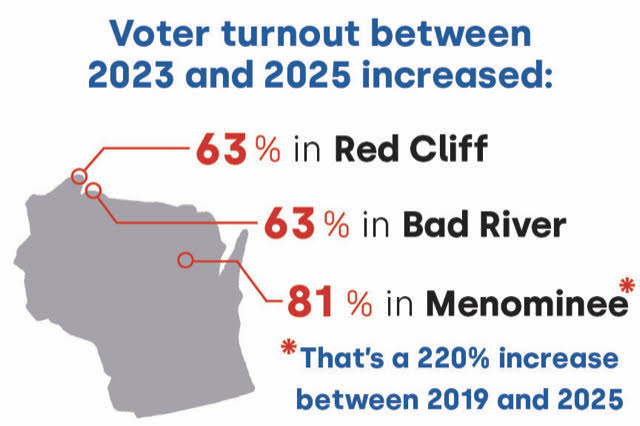
- Details
- By Neely Bardwell
Native Vote. In the Wisconsin Supreme Court election held on April 1 that resulted in Dane County Judge Susan Crawford winning and preserving the court’s left leaning majority, Native Americans in the state set records for voter turnout.
According to the Wisconsin Conservation Voters, a non-partisan voter advocacy orgranization, voter turnout between 2023 and the 2025 Supreme Court Election increased 63 percent in Red Cliff, 63 percent in Bad River, and 81 percent in Menominee. For the Menominee Nation, that is a 220 percent increase between 2019 and 2025.
Maria Haskins (Anishinaabe, Lac Courte Oreilles, Stockbridge, and Oneida), the Wisconsin Native Vote Regional Tribal Organizer for Wisconsin Conservation Voters, told Native News Online that after the 2024 presidential election, voters were tired and apathetic.
“Here's what we know; we know that the primaries for the Wisconsin spring elections are very very low voter turnout, and we also know that races like the Supreme Court are typically like lower voter turnout anyway,” explained Haskins. “We were able to partner with the Native American Rights Fund and have different community dinners. All dinners were very well attended. All had very good feedback.”
The community dinners were held in areas where the Native population is the highest like Milwaukee, Bad River, and Menominee. They held the dinners to educate, register, and empower Native voters.
The dinners weren't the only efforts to get out the vote for the Supreme Court Election, Haskins explains they also held text banking, sent mail pieces, and attended local community events to register eligible voters.
“Looking into numbers after the election and seeing that huge increase in turnout, it really just gives you hope and motivation to keep going,” explained Haskins when asked about how it felt to see their hard work come to fruition. “We're just a small piece of this work. We're not the only organization out there encouraging people to get out there and vote.”
The Menominee voting area saw the biggest voter turnout with some Menominee citizens running for local seats.
“I'm also really grateful for people in the Menominee community who ran for office. I truly feel like all of those people who ran for those empty seats, that's what also got people to the polls,” said Haskins. “I think that's really remarkable. Menominee really showed how a community can come together.”
More Stories Like This
Native News Weekly (August 25, 2024): D.C. BriefsUS Presidents in Their Own Words Concerning American Indians
Indigenous Actor Elaine Miles Reports Detention by Alleged ICE Agents
Happy Thanksgiving from Native News Online
Coming Up on Native Bidaské: Behind the Animation: Joey Clift Talks “Pow” and Native Storytelling
Help us tell the stories that could save Native languages and food traditions
At a critical moment for Indian Country, Native News Online is embarking on our most ambitious reporting project yet: "Cultivating Culture," a three-year investigation into two forces shaping Native community survival—food sovereignty and language revitalization.
The devastating impact of COVID-19 accelerated the loss of Native elders and with them, irreplaceable cultural knowledge. Yet across tribal communities, innovative leaders are fighting back, reclaiming traditional food systems and breathing new life into Native languages. These aren't just cultural preservation efforts—they're powerful pathways to community health, healing, and resilience.
Our dedicated reporting team will spend three years documenting these stories through on-the-ground reporting in 18 tribal communities, producing over 200 in-depth stories, 18 podcast episodes, and multimedia content that amplifies Indigenous voices. We'll show policymakers, funders, and allies how cultural restoration directly impacts physical and mental wellness while celebrating successful models of sovereignty and self-determination.
This isn't corporate media parachuting into Indian Country for a quick story. This is sustained, relationship-based journalism by Native reporters who understand these communities. It's "Warrior Journalism"—fearless reporting that serves the 5.5 million readers who depend on us for news that mainstream media often ignores.
We need your help right now. While we've secured partial funding, we're still $450,000 short of our three-year budget. Our immediate goal is $25,000 this month to keep this critical work moving forward—funding reporter salaries, travel to remote communities, photography, and the deep reporting these stories deserve.
Every dollar directly supports Indigenous journalists telling Indigenous stories. Whether it's $5 or $50, your contribution ensures these vital narratives of resilience, innovation, and hope don't disappear into silence.
 The stakes couldn't be higher. Native languages are being lost at an alarming rate. Food insecurity plagues many tribal communities. But solutions are emerging, and these stories need to be told.
The stakes couldn't be higher. Native languages are being lost at an alarming rate. Food insecurity plagues many tribal communities. But solutions are emerging, and these stories need to be told.
Support independent Native journalism. Fund the stories that matter.
Levi Rickert (Potawatomi), Editor & Publisher

